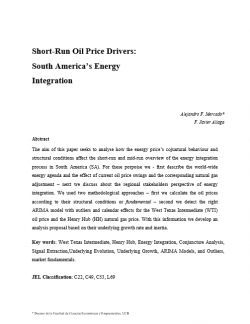Short-Run Oil Price Drivers: South America`s Energy Integration
DOI:
https://doi.org/10.35319/lajed.200912166Keywords:
West Texas Intermediate, Henry Hub, Energy Integration, Conjuncture Analysis, Signal Extraction, Underlying Evolution, Underlying Growth, ARIMA Models, Outliers, market fundamentalsAbstract
The aim of this paper seeks to analyse how the energy prices cojuntural behaviour and structural conditions affect the short-run and mid-run overview of the energy integration process in South America (SA). For these porpoise we - first describe the world-wide energy agenda and the effect of current oil price swings and the corresponding natural gas adjustment - next we discuss about the regional stakeholders perspective of energy integration. We used two methodological approaches - first we calculate the oil prices according to their structural conditions or fundamental - second we detect the right ARIMA model with outliers and calendar effects for the West Texas Intermediate (WTI) oil price and the Henry Hub (HH) natural gas price. With this information we develop an analysis proposal based on their underlying growth rate and inertia.
Downloads
References
Aznar, A. and Trívez, F.J. (1993b): Métodos de predicción en Economía. Vol. II: Análisis de series temporales. Ed. Ariel. Barcelona.
Baker, J. (2006): “Los altos precios del petróleo van para largo”. Wealth Management, 22, pp.13-15.
Brown, S.P.A.. (2005). “Natural Gas Pricing: Do Oil Prices Still Matter?” Federal Reserve Bank of Dallas. Southwest Economy. July/August: pp. 9-11.
Chambers, J.C., Mullick, S.K. and Smith, D.D. (1971): “How To Choose the Right Forecasting Technique”. Harvard Business Review, pp. 65, 45-74.
Chen, C., Liu, L.M. and Hudak, G.B. (1990): “Outlier Detection and Adjustment in Time Series Modeling and Forecasting”. Working Paper Series. SCA.
Chen, C. and Liu, L.M. (1993a): “Joint Estimation of Model Parameters and Outlier Effects in Time Series”. Journal of the American Statistical Association, pp. 88, 284-297.
Chen, C. and Liu, L.M. (1993b): “Forecasting Time Series with Outliers”. Journal of Forecasting, pp. 12, 13-35.
Chen, C. and Tiao, G.C. (1990): “Random Level-Shift Time Series Models, ARIMA Approximations and Level-Shift Detection”. Journal of Business and Economic Statistics, pp. 8, 83-97.
Energy Information Administration (EIA), Annual Energy Outlook 2007, DOE/EIA- 0383(2006) (Washington, DC, February 2006), pp. 1-14
Hillmer, S.C., Bell, W.R. and Tiao, G.C. (1983): “Modeling Considerations in the Seasonal Adjustment of Economic Time Series”. En Zellner, A. (ed.): Applied Time Series Analysis of Economic Data. U.S. Department of Commerce Bureau of the Census, Washington DC., pp. 74-100.
Jabir, Imad. (2006). “Examining the Long-Run Relation Among Spot Prices of Crude oil and Natural Gas.” Working paper. IAEE International Conference, Potsdam, Germany: June 2006.
Olade (2005): “A Review of the Power Sector in Latin America and the Caribbean, Evolution in the Market and Investment Opportunities for CFTs”. March 2005.
Panagiotidis, T., and E. Rutledge (2004). "Oil and Gas Market in the UK: Evidence From a Cointegration Approach." Economics Dept, Loughborough University. Discussion Paper Series: November 2004.
Pindyck, R. (2001): “The Dynamics of Commodity Spot and Futures Markets: a Primer”, The Energy Journal, pp. 22, 14-18.






